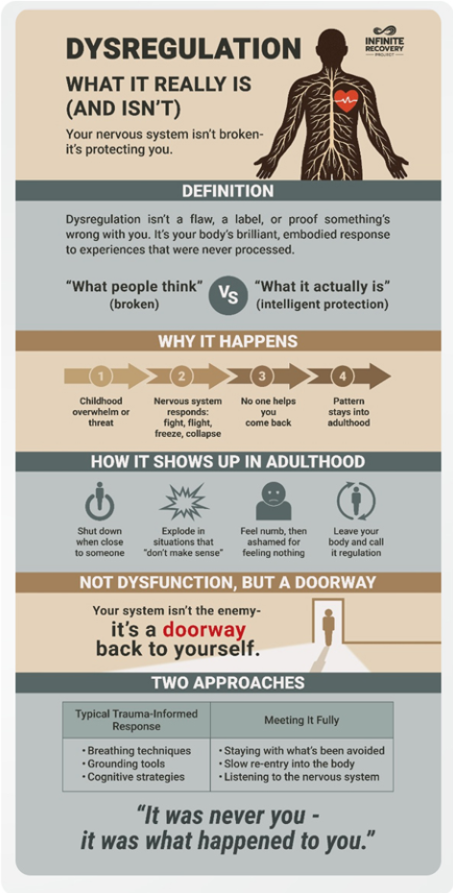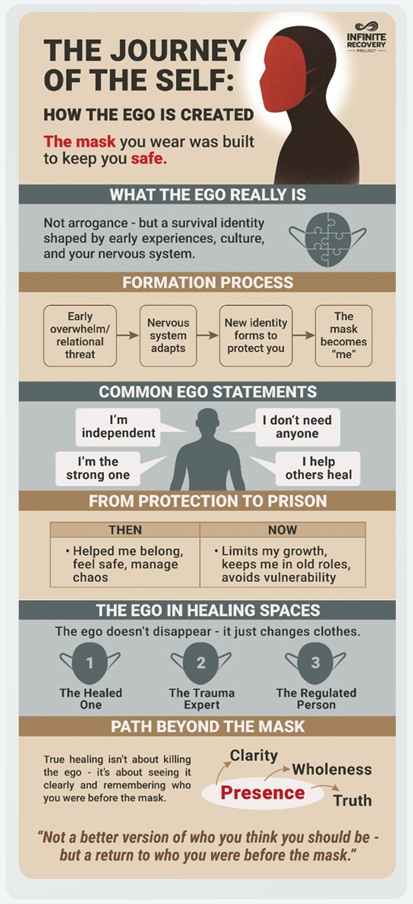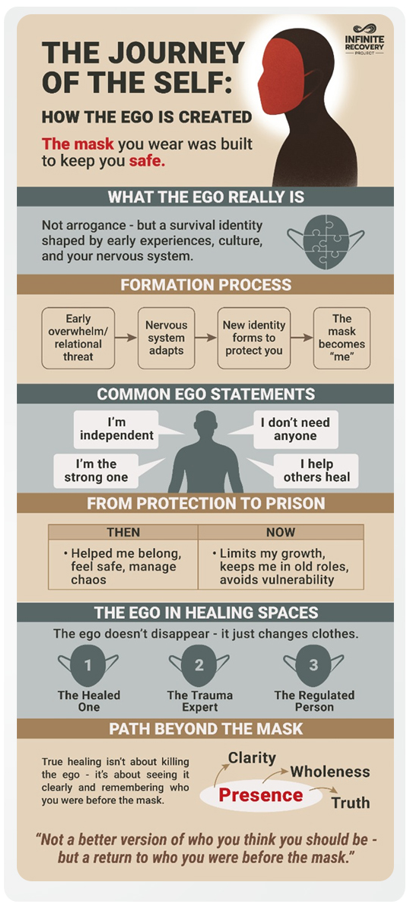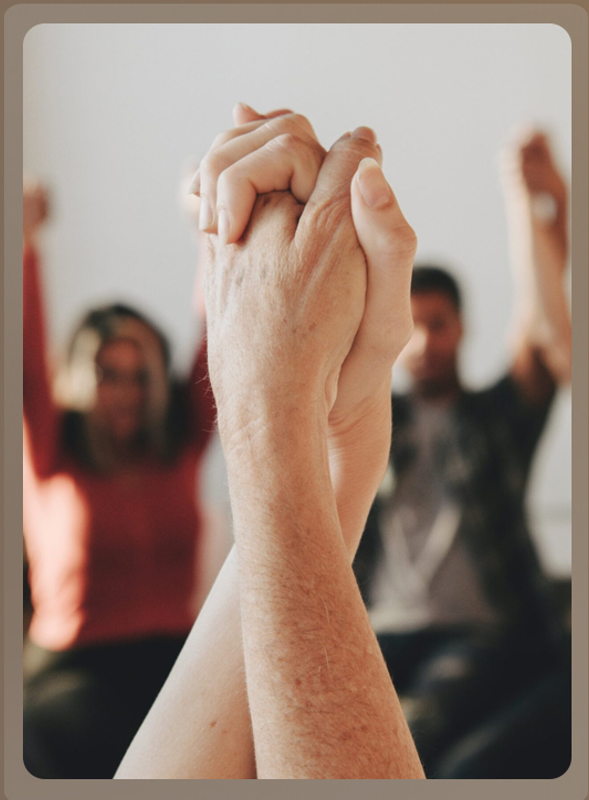Whoisthisfor/professionals-addiction
Beyond Trauma Informed
Trauma Healing vs Trauma-Informed

“Trauma-informed” has become the new badge of honour. It’s printed on websites, mentioned in bios, dropped in trainings. And on the surface, it sounds like progress – professionals becoming aware that trauma shapes lives, nervous systems, relationships, and behaviour.
But awareness isn’t embodiment, and language isn’t healing.
Being trauma-informed often means we can name what’s happening, we know the polyvagal theory, we understand “fight, flight, freeze, fawn” We’re careful with our words, our tone, our triggers. We might even use the right models and interventions.
But none of that means the trauma has healed.
Because trauma isn’t just a story in your mind, it’s a physiological imprint in the body. It’s stored, suppressed, woven into your way of being. You can learn everything there is to know about trauma and still feel completely stuck in it, still act from it, still live inside it.
That’s the uncomfortable truth no one wants to admit – Most trauma-informed work happens from the trauma response – not beyond it.
It’s the mind trying to understand what the body has not yet released.
And so we keep going in circles:
While inside, we’re still holding our breath, still subtly ashamed of what we can’t fix.
Trauma healing doesn’t happen by understanding trauma.
It happens in the spaces where we feel what was never felt. Where we meet the part of us that froze, fought, shut down, or disappeared, where we stop managing and start being with.
Real healing is raw, it’s often slow, and it rarely looks impressive from the outside.
But it’s the only thing that brings you home.
The Mind and Belief-Driven Discovery
Just like “trauma-informed” can stop at the surface, most people never question the mind itself.
They live inside it – its stories, strategies, identities, and inherited ideas – assuming that thinking about healing is the same as being healed. This is where most recovery, therapy, and even spiritual paths quietly get stuck.
Because when the mind leads the journey, healing becomes about managing experience:
 Creating a better self-concept.
Creating a better self-concept.
 Repeating affirmations.
Repeating affirmations.
 Building new beliefs to replace the old ones.
Building new beliefs to replace the old ones.
 Learning the right tools, the right steps, the right techniques.
Learning the right tools, the right steps, the right techniques.
It feels like progress. It feels ‘empowered’ But it’s still the same loop - just better decorated. The truth is the mind cannot lead you home to yourself, because it wasn’t built for that. It was built to protect, predict, categorise, control. It wants answers, frameworks, identities - because those things feel safer than the mess and mystery of actually being with what’s real.

And so we mistake, understanding for transformation, language for embodiment, frameworks for freedom. This is why people can know everything about trauma, addiction, nervous systems, and still feel totally lost, still be over reactive, still feel like frauds in their own healing. Because the parts of us that need love and contact the most – the parts shaped in preverbal moments, in non-verbal disconnection, cannot be reached through intellect. Belief-driven discovery creates another layer of self – a new identity to maintain – trauma informed person, business, group, process.
But healing asks us to lose those layers, the expert status, the teacher, the know it all. To stop performing, explaining, achieving – and instead feel what’s underneath, there is nothing wrong with learning, but if it doesn’t bring you closer to your body, your heart, your truth – then it’s just another clever way to avoid yourself – and keep what’s buried, buried.
Suppression, Repression & the Mess of
Unearthing What’s Been Buried
Not forgotten – just buried.

Innocence – Tenderness – Playfulness
All of it pushed down, out of sight… but not out of my nervous system, and that’s what most people don’t understand about healing. It’s not about becoming better, It’s about finally feeling what you never got to feel. Not intellectually, not through insight but in your body – in the raw, unedited truth of the moment, that’s where things started shifting for me.Not in the years I spent trying to understand myself…but in the moments I stopped performing healing – and actually let myself break. Where I stopped being Jason Expert Addiction Specialist, Psychotherapist, Coach Accredited etc etc.
It’s messy work, because the truth doesn’t rise up neatly, it comes out in waves, in symptoms, in behaviours that don’t match the story you’re trying to live.
You might find yourself:
- Addicted again, but not to substances – to work, to service, to helping others.
- Struggling in relationships that mirror your earliest wounds.
- Feeling lost, even though you’ve done all the work.
This is what happens when suppression starts to lift, it’s not a straight line, it doesn’t look pretty on Instagram, it’s disorienting, embarrassing, because you’ve spent so long being the strong one, the sorted one, the professional one…and then suddenly, you’re not.
But that’s not failure, It’s embracing yourself.
The body is trying to speak, the old protections are thinning, you’re finally getting close to what’s real. And when you do, the nervous system starts to speak – not through insight, but through dysregulation.
Dysregulation -
What It Really Is (and Isn’t)
The word ‘dysregulated’ gets thrown around a lot – especially in healing spaces, but most people using the term don’t actually understand what it means. Dysregulation isn’t a flaw, or a mental health label, it’s not proof that something’s wrong with you.
It’s a signal, a language, a brilliant, embodied response to experiences that were never processed.
When you were five years old, overwhelmed and alone, your nervous system did what it needed to do to survive, it held the intensity for you, it froze, it fled, it fought, it collapsed. And because no one helped you come back, that pattern stayed.
So now, as an adult:
• You might shut down when you get close to someone.
• You might explode in moments that don’t make sense.
• You might feel numb, then ashamed for feeling nothing.
• You might leave your body altogether and call it regulation
Most trauma-informed approaches try to manage dysregulation – instead of meeting it.
They offer grounding techniques, breathing methods, cognitive tools – all helpful in a moment of crisis…
But none of that teaches you how to be with what you’ve been avoiding your whole life, real regulation isn’t learned from a handout, it’s rediscovered, remembered, as you slowly come home to your body in the moment, as it happens. The nervous system doesn’t need to be fixed, it needs to be listened to.

And that’s not a quick process
It’s a slow, sacred unravelling of everything you thought was wrong with you – until you realise it was never you, it was what happened to you. And that changes everything, how we see ourselves, how we see others, and what we call healing.
The Journey of the Self: How the Ego Is Created

Long before we’re conscious of it, we begin constructing a version of ourselves that can survive. This is the start of what we call the ego – not in the inflated, arrogant sense often used in everyday language, but as a necessary identity that forms to help us belong, be safe, and feel in control.
The ego isn’t the enemy, it’s an intelligent adaptation – shaped by early experiences, family dynamics, cultural expectations, and the nervous system’s attempts to regulate overwhelming environments. It becomes the mask we wear to be loved, to avoid abandonment, to manage chaos.
Over time, that mask solidifies, we forget it was something we created, and start believing it’s who we are.
We say:
‘I’m independent,’
‘I’m the strong one,’
‘I don’t need anyone,’
or,
‘I help others heal.’
These identities may have once kept us safe, but they eventually become prisons. We perform them long after the original threat is gone, we develop belief systems to justify them, and we seek out experiences – even healing experiences – that reinforce the very ego structures we need to outgrow.
This is why many people on spiritual or therapeutic paths end up deeply identified with being ‘the healed one,’ or ‘the trauma expert,’ or ‘the regulated person.’ The ego doesn’t disappear – it just changes clothes.
True healing invites something more honest – not to kill the ego, or transcend it, but to see it clearly. To recognise where it was formed, how it’s been useful, and where it’s now keeping us from our own truth.
This isn’t comfortable work, you may lose identities you’ve clung to for years, you may feel grief, anger, or deep confusion. But beneath the ego’s defences is the part of you that was never constructed – the part that simply is.
That’s what real recovery points to not a better version of who you think you should be, but a return to who you were before the mask.
And that journey isn’t led by frameworks, titles, or ideologies.
It’s led by presence.
The Seduction of Ideology and
the Trap of Hierarchy
Most people don’t join belief system driven communities because they’re weak. They join them because they’re scared, because the rawness of life without a guidebook feels unbearable, and ideology – whether it’s the 12 steps, a healing modality, a trauma framework, or a spiritual path like non duality – promises clarity, community, and answers.
It feels like relief, and at first, it might be.
But over time, ideology becomes another version of the ego’s armour – a way of feeling secure in the world, rather than becoming free in it. It says:
‘Here’s the way – Follow it.’
‘Here’s the leader – Trust them.’
‘Here are the rules – Obey them.’
‘Here’s the language – Use it correctly.’
And suddenly, healing becomes performance again – just dressed in softer words.
Hierarchy reinforces this, in almost every system, someone rises to the top, becomes the expert, the teacher, the one with the answers. Others follow, hoping that proximity to this knowledge will offer the same peace. But what’s rarely asked is – Does this person even live what they teach? Or are they, too, clinging to their own scaffolding?
This isn’t to shame those who guide or lead – but to point out that in the deepest kind of healing, there are no true leaders. There are only mirrors, fellow humans walking the path of remembering.
When we outsource our healing to systems, leaders, or methods, we lose the very thing that’s trying to be found – our own inner authority.

This doesn’t mean we don’t need support, it means we have to discern when support becomes submission. When frameworks stop serving and start limiting, when language becomes dogma, when curiosity is replaced with certainty.
Because anything that asks you to abandon your own experience, or rank yourself against an external ideal – no matter how “trauma-informed” or “spiritual” it sounds – is not a healing path, it’s a performance in disguise.
Real recovery breaks hierarchy, it doesn’t create new ones, it doesn’t give you a better system to believe in – it brings you back to the place where belief itself can fall away.
The question is never: “What system do I follow now?”
It’s: “What parts of me am I still afraid to meet without one?”
The Addiction Cycle, Papering Over Cracks,
and the Illusion of Progress
For most people, addiction isn’t just about substances, it’s about escape. About reaching for anything that soothes what we haven’t yet been able to feel. Once the drugs or alcohol are gone, the same inner ache often finds new outlets – overworking, spiritual bypassing, people-pleasing, compulsive helping, food, sex, relationships, gambling or the pursuit of healing itself.
This is the part that rarely gets acknowledged – especially in recovery spaces. Because if we’re not careful, recovery becomes just another role, a new identity for the ego, a place to hide.
The person who was addicted to chaos now becomes addicted to fixing it. The one who sought oblivion through substances now seeks it through service, or achievement, or endless self-improvement. The pain hasn’t been met – it’s just wearing different clothes.

And that’s what happens when we paper over cracks.
We create new belief systems, new rules, new ways of coping… and call it healing. But nothing has really changed underneath. The foundation is still cracked – we’ve just repainted the walls.
This is why people relapse after years of being ‘clean’. Why therapists burn out while quoting regulation theory and why people in long-term recovery find themselves secretly self-medicating in other ways
The problem with ideology – even healing ideology – is that it often repeats the very dynamic we’re trying to escape: control over connection, performance over presence, image over truth, and this isn’t just a personal issue – it’s structural.
Treatment centres praise clients for compliance, therapists are rewarded for appearing unshakable, healing spaces often celebrate language over lived experience. So even as we talk about trauma, we keep avoiding it – because we’re still trying to fix something, rather than feel it.
It asks you to give up the story of being ‘sorted’ and meet the parts that still hurt. It asks you to get curious about your patterns, your cycles, your shame – not to pathologise them, but to understand what they’ve been protecting.
Because when you stop reaching for another tool, another title, another identity… You might finally meet what’s always been underneath – the part of you that never needed fixing – just connection.
Hidden Addictions & Secret
Struggles in Recovery
One of the most confronting truths I had to face in my own journey – and one I’ve seen echoed in countless others, including professionals – is this:
People leave substances but find themselves compulsively working, rescuing, controlling, dieting, spiritualising, obsessing over health, endlessly scrolling, or chronically helping others. Outwardly, it looks like progress, but inwardly, the same nervous system patterns are playing out – only now they’re hidden behind more socially acceptable masks.
This isn’t a personal failure, it’s what happens when healing doesn’t touch the deeper layers – when trauma isn’t just suppressed, but cleverly rebranded as transformation.

I’ve worked with therapists, counsellors, and leaders who could speak fluently about trauma-informed care, regulation, somatics – but were still operating from their own survival strategies. Quietly anxious, chronically dysregulated, addicted to control or certainty, and still running on the same core fear – If I stop performing, I’ll be exposed.
The system often rewards this, in many recovery circles, being ‘sorted’ becomes the new identity. You’re meant to have it together – clean time, a strong message, a stable life. But behind that image, many are struggling silently and the longer you wear the mask, the harder it becomes to take it off.
Because to do so would mean admitting: I’m still in it.
And we’ve made that admission taboo.
• Addiction isn’t just about what you use – it’s about what you can’t be with.
• Recovery isn’t just about stopping behaviours – it’s about meeting the parts of you that those behaviours were protecting.
• And no matter how long you’ve been in the field, if you’re still numbing, hiding, or performing – there’s more to see.
This isn’t said with judgment, it’s said with deep compassion.
Because I’ve lived it.
It took me years to admit that the healing identity I had built was just another addiction – and that real recovery began when I let it fall apart. When I stopped striving to be the professional, and allowed myself to be a person.Reflection
If you’re someone others look up to, are you still allowed to struggle?
If your identity is built around being ‘recovered’ or ‘healed’, what happens when that no longer feels true?
The trap of being the “sorted one” is that your humanity becomes a liability – when it was always your greatest gift.
Conclusion - The Return to Self
After all the frameworks, roles, and identities we build in the name of healing, there comes a quieter moment – a moment when we’re asked to return. Not to a better version of ourselves, or a new identity we’ve constructed from all we’ve learned – but to something far older, something untouched.
The Self.
Not the ego self, not the performance of regulation, not the curated image of someone who has done the work. The real Self – the one that was never wounded, never disconnected, never broken, the one we didn’t create, the one we forgot.
Throughout this piece, we’ve named how easy it is to mistake trauma awareness for trauma healing, to follow frameworks that quietly reinforce performance, to live inside the mind’s strategies and the ego’s masks, thinking we’re making progress. But real recovery doesn’t lead you into more roles, more language, or more ideas. It leads you back to presence. It leads you home.

The Self Is Not Found in the Mind
If you break open a radio to look for the voice, you won’t find an announcer inside. The sound isn’t coming from the box – it’s coming through it. The same is true of the mind, you can dissect it, analyse it, name every part – but you will never find the soul inside. The soul is not a structure, it’s the signal, it’s what you are, not what you’ve built.
And that’s where most healing models fall short. They keep pointing you toward the box – the nervous system, the behaviours, the models, the diagnoses – and they forget that the thing you’re looking for isn’t inside the structure, it’s beyond it, it’s behind It, it’s what’s been quietly watching the whole time.
The Qualities of the Self
When we return to this place – this essence beyond trauma, beyond identity, beyond performance – we don’t become perfect, we become present.
In that presence, we often rediscover what Internal Family Systems calls the 8 Cs – calm, clarity, compassion, courage, curiosity, confidence, connectedness, and creativity. Not as traits to strive for, but as natural qualities that emerge when we stop managing experience and start being with it.
This isn’t the confidence of performance, it’s the confidence of truth, not the clarity of certainty, the clarity of contact.
When you are with your Self, you don’t need a framework. You don’t need to be right, you don’t need to convince anyone, you are no longer trying to be sorted – you’re simply here.
Why Community Might Still Be Part of the Journey
This return is deeply personal – but we’re not meant to walk it alone.
The Self may be what we return to, but often it’s other humans that hold the mirror, a group, a companion, a shared space can help us see what we’ve forgotten. Not because they have the answers, but because they’re willing to not know with us.
There is no hierarchy in real healing, there are no experts of your soul. There are only humans on their own path, willing to be witnessed, willing to be wrong, willing to show up again and again without the mask.
Healing community is not about leadership – it’s about reflection, not ‘here’s the way’ but ‘I’ll walk with you while you find yours.’
The Soul Was Never Broken
This return isn’t about becoming someone new, it’s about softening into who you already are – beneath the addictions, beneath the roles, beneath the rules. It’s about remembering that what was real in you never left. It was just covered by years of protection, of noise, of frameworks that asked you to fix something that was never broken.
The soul doesn’t live in the mind, it lives in the breath, the silence, the stillness beneath the storm.
No ideology can give you that and No teacher can deliver it.
At best, they can remind you it’s there – and step out of the way.
So What Does It Mean to Return?
It means listening more deeply than you ever have, It means letting go of roles, even the ones that made you feel safe, it means releasing the story that says, I have to know what I’m doing to be ok.
The Self doesn’t need a title, it doesn’t need a framework, it doesn’t need to be impressive or consistent.
It just wants you to stop leaving.
You can sit in a room full of people – therapists, clients, seekers, addicts, helpers – and know this:
No one is ahead of you.
No one is behind you.
We’re all just finding our way back.
The danger isn’t being trauma-informed – it’s stopping there, mistaking it for the destination.
